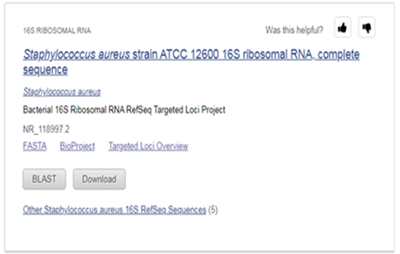Staphylococcus aureus: Molecular Genetic Bioinformatics and Evolutionary Relationships
Abstract
Staphylococcus aureus is a type of Gram-positive bacteria, usually living on human skin, in the nasal cavity or in the respiratory tract. This type of bacteria has several characteristics: coagulation-positive, DNA decoding, and its consumption of mannitol-type sugar. Although it does not always cause disease, one of the diseases caused by this type of germ is toxic shock syndrome, which leads to severe illness accompanied by fever, a widespread red rash with the effect of other organs in the body. Recently, new types of antibiotic-resistant Staphylococcus aureus have emerged, the most important of which is methicillin-resistant Staphylococcus aureus, which is an RNA component of the 30s subunit of the prokaryotic ribosome (SSU rRNA). It is related to the TTS of Shine-Dalgarno tuberculosis and provides most of the SSU structure. The genes encoding it are referred to as the 165 rRNA gene and are used in reconstructing strains due to the slow evolutionary rates of this region of the gene Genetics Multiple sequences of the 16s rRNA gene can exist within a single bacterium To identify the bacteria in a given sample, this procedure uses 165 rRNA gene sequencing, which is currently the most cost-effective method for comprehensive determination of bacterial taxonomy and relative quantitative performance. Alternative methods include targeted.
Full text article
References
Lowy FD. Staphylococcus aureus infections. N Engl J Med. 1998 Aug 20;339(8):520-32. [PubMed]
Centers for Disease Control and Prevention (CDC). Outbreaks of community-associated methicillin-resistant Staphylococcus aureus skin infections--Los Angeles County, California, 2002-2003. MMWR Morb Mortal Wkly Rep. 2003 Feb 07;52(5):88. [PubMed]
Boucher HW, Corey GR. Epidemiology of methicillin-resistant Staphylococcus aureus. Clin Infect Dis. 2008 Jun 01;46 Suppl 5:S344-9. [PubMed]
Rasigade JP, Vandenesch F. Staphylococcus aureus: a pathogen with still unresolved issues. Infect Genet Evol. 2014 Jan;21:510-4. [PubMed]
von Eiff C, Peters G, Heilmann C. Pathogenesis of infections due to coagulase-negative staphylococci. Lancet Infect Dis. 2002;2:677–85. 10.1016/S1473-3099(02)00438-3 [PubMed] [CrossRef] [Google Scholar]
Seifert H, Wisplinghoff H, Schnabel P, von Eiff C. Small colony variants of Staphylococcus aureus and pacemaker-related infection. Emerg Infect Dis. 2003;9:1316–8. [PMC free article] [PubMed] [Google Scholar]
Becker K, Harmsen D, Mellmann A, Meier C, Schumann P, Peters G, et al. Development and evaluation of a quality-controlled ribosomal sequence database for 16S ribosomal DNA-based identification of Staphylococcus species. J Clin Microbiol. 2004;42:4988–95. 10.1128/JCM.42.11.4988-4995.2004 [PMC free article] [PubMed] [CrossRef] [Google Scholar]
Lelieveld SH, Veltman JA, Gilissen C. Novel bioinformatic developments for exome sequencing. Hum. Genet. Springer Verlag; 2016. p. 603–14.
Mooney SD, Krishnan VG, Evani US. Bioinformatic tools for identifying disease gene and SNP candidates. Methods Mol. Biol. Humana Press Inc.; 2010. p. 307–19.
Hsu HW, Su HY, Huang PH, Lee BL, Liu HJ, Sequence andphylogenetic analysis of P10- and P17-encoding genes of avianreovirus. Avian Dis. 2005; 49(1):36-42.
Authors
Copyright (c) 2024 https://creativecommons.org/licenses/by/4.0/

This work is licensed under a Creative Commons Attribution 4.0 International License.
